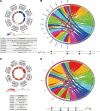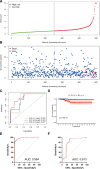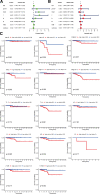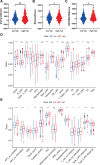Bioinformatics analysis of the prognostic and clinical value of senescence-related gene signature in papillary thyroid cancer
- PMID: 37266618
- PMCID: PMC10238039
- DOI: 10.1097/MD.0000000000033934
Bioinformatics analysis of the prognostic and clinical value of senescence-related gene signature in papillary thyroid cancer
Abstract
Cellular senescence can both inhibit and promote the occurrence of tumors, so how to apply cellular senescence therapy is of great importance. However, it is worth to be analyzed from multiple perspectives by researchers, especially for tumors with a high incidence like papillary thyroid cancer (PTC). We obtained senescence-related differentially expressed genes (SRGs) from The Cancer Genome Atlas (TCGA) and gene expression omnibus database. Enrichment analysis of SRGs was performed via gene ontology and Kyoto Encyclopedia of Genes and Genomes. Prognostic model was constructed by univariate and multivariate Cox regression analysis. Evaluation of clinical value was analyzed via Receiver operating characteristic curve, Kaplan-Meier curve and Cox regression. Immune infiltrates were investigated through ESTIMATE and single-sample gene set enrichment analysis. Immunohistochemical images were obtained from The Human Protein Atlas. Twenty-seven SRGs from TCGA cohort and gene expression omnibus datasets were found. These genes are mainly concentrated in senescence-related terms and pathways, including "DNA damage response, signal transduction by p53 class mediator," "signal transduction in response to DNA damage," "p53 signaling pathway" and "Endocrine resistance." Based on SRGs, prognostic model was constructed by E2F transcription factor 1, snail family transcriptional repressor 1 and phospholipase A2 receptor 1. PTC patients were divided into a low-risk group and a high-risk group according to the median value (cutoff point = 0.969) of risk score in TCGA cohort. The diagnostic efficiency of this model is good (area under curve = 0.803, 0.809, and 0.877 at 1, 2, and 3 years in TCGA; area under curve = 0.964, 0.813 in GPL570 and GPL96), particularly advanced grade, state and tumor mutation burden, such as Stage III - IV, T3 - 4, H-tumor mutation burden. Furthermore, High-risk group was significantly associated with poor prognosis and more immune infiltration. Our prognostic model has a good diagnostic and prognostic efficacy, and there is a certain clinical application value. In addition, we provide the first new insight into the genesis, diagnosis, prognosis and treatment of PTC based on senescence-related genes.
Copyright © 2023 the Author(s). Published by Wolters Kluwer Health, Inc.
Conflict of interest statement
The authors have no funding and conflicts of interest to disclose.
Figures






Similar articles
-
Identification of lipid metabolism-related genes as prognostic indicators in papillary thyroid cancer.Acta Biochim Biophys Sin (Shanghai). 2021 Dec 8;53(12):1579-1589. doi: 10.1093/abbs/gmab145. Acta Biochim Biophys Sin (Shanghai). 2021. PMID: 34693452
-
Identification of ferroptosis genes in immune infiltration and prognosis in thyroid papillary carcinoma using network analysis.BMC Genomics. 2021 Jul 27;22(1):576. doi: 10.1186/s12864-021-07895-6. BMC Genomics. 2021. PMID: 34315405 Free PMC article.
-
Identification of iron metabolism-related genes as prognostic indicators for papillary thyroid carcinoma: a retrospective study.PeerJ. 2023 Jun 21;11:e15592. doi: 10.7717/peerj.15592. eCollection 2023. PeerJ. 2023. PMID: 37361050 Free PMC article.
-
Construction and validation of a prognostic model based on stage-associated signature genes of head and neck squamous cell carcinoma: a bioinformatics study.Ann Transl Med. 2022 Dec;10(24):1316. doi: 10.21037/atm-22-5427. Ann Transl Med. 2022. PMID: 36660709 Free PMC article.
-
Identifying key genes of classic papillary thyroid cancer in women aged more than 55 years old using bioinformatics analysis.Front Endocrinol (Lausanne). 2022 Sep 2;13:948285. doi: 10.3389/fendo.2022.948285. eCollection 2022. Front Endocrinol (Lausanne). 2022. PMID: 36120433 Free PMC article.
Cited by
-
Cellular senescence in cancer: from mechanism paradoxes to precision therapeutics.Mol Cancer. 2025 Aug 8;24(1):213. doi: 10.1186/s12943-025-02419-2. Mol Cancer. 2025. PMID: 40781676 Free PMC article. Review.
References
-
- Sung H, Ferlay J, Siegel RL, et al. . Global cancer statistics 2020: GLOBOCAN estimates of incidence and mortality worldwide for 36 cancers in 185 countries. CA Cancer J Clin. 2021;71:209–49. - PubMed
-
- Seib CD, Sosa JA. Evolving understanding of the epidemiology of thyroid cancer. Endocrinol Metab Clin North Am. 2019;48:23–35. - PubMed
-
- Fagin JA, Wells SA. Biologic and clinical perspectives on thyroid cancer. N Engl J Med. 2016;375:2306–7. - PubMed
-
- Haugen BR, Alexander EK, Bible KC, et al. . 2015 American thyroid association management guidelines for adult patients with thyroid nodules and differentiated thyroid cancer: the American thyroid association guidelines task force on thyroid nodules and differentiated thyroid cancer. Thyroid. 2016;26:1–133. - PMC - PubMed
MeSH terms
Substances
LinkOut - more resources
Full Text Sources
Medical
Research Materials
Miscellaneous

